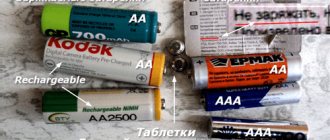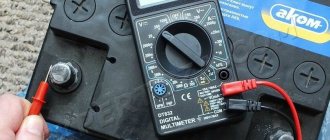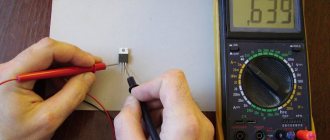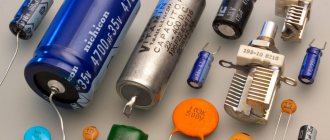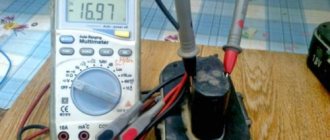Every day, people use phones, tablets, remote controls, and dozens of other electronic devices, usually operating independently from a battery. Gradually, used batteries accumulate at home; some of them are still suitable for use. At the same time, spent disposable sources cannot be stored at home - an electrolyte leak may occur at any time, which can damage furniture and equipment. There are several ways to test a battery for functionality, but each requires the use of a tester.
Testing the battery with a multimeter is necessary to determine its performance.
Content:
These designations for cylindrical batteries are as follows: D, C, AA, AAA.
This order corresponds to a decrease in size. * Another international designation standard has also become widespread: LR20, LR14, LR6, LR03, 6F22. It contains two main parameters that describe the size and shape of the battery, as well as the electrochemical system on which the cell is built.
The first letter in the designation contains information about the chemical structure of the element. If this is the letter “L”, then you have an alkaline battery, if “S” then it is a silver-zinc battery, if it is “C” then it is a lithium battery, if this letter is not there then it is a salt battery.
How to make a device with your own hands
When the necessary equipment is not available, you can make the device yourself by watching the video. It is necessary to take a voltmeter from ready-made instruments, and the remaining parts are constructed from improvised means. Difficulties will arise when calculating and creating internal resistance, which requires current.
A suitable material is nichrome wire, used to create heating coils in electric stoves. Nichrome elements can be replaced with a metal strip from other heating devices.
For a voltage of 12 V, the current indicator should be within 80-120 Amperes, and the resistance should be 0.1-0.15 Ohms. A device for measuring such resistance is difficult to find. For this reason, the length of one element is selected and the current that it passes is measured. After this, several similar parts are combined.
A homemade device is made sequentially:
- Select a nichrome wire or heating strip and measure the current up to 15 A with a multimeter. The element should pass 10-12 A.
- 10 such parts are connected, receiving a load of 100-120 A. The wire must be twisted securely.
- The resulting element is placed in a suitable housing and fixed in it. If the box is small, then the wire is bent several times so that the turns do not touch each other. The parallel connection must be reliable, which is ensured by insulating cylinders that are installed on the bends.
- The ends of the twist are soldered to the output contacts, and from the outside to the connecting wires.
- Connect a voltmeter.
- Clamps are attached to the ends of the connecting cable, which are then connected to the battery.
When the device is ready, you can take measurements at home.
A simple test of the battery capacity with a tester and subsequent clarification
A USB tester is often used to measure battery capacity. The device has many functions that allow you to find out the battery capacity of a smartphone, tablet and external power bank.
The USB tester connects to any portable device via a cable or adapter.
The obtained indicators help determine battery wear. The tester has a control button designed to measure various indicators. With its help, the operating modes and memory cells of the device are switched.
When the connected device has the required voltage, the tester starts working. The battery capacity value appears in the bottom corner. The tester does not give a 100% correct result.
For this reason, you can use mathematical calculations using the formula: initial current indicator * 3 = actual battery capacity. Some manufacturers list a rated capacity on the device that is higher than the actual capacity. This information is incorrect and is an advertisement.
Checking electric batteries with a multimeter under load
The remaining elements are retested. Let's now figure out how to check the battery capacity under load. To do this you need to proceed as follows:
- Connect the multimeter probes to the contacts of the battery being tested.
- Connect the load element in parallel and wait 30-40 seconds.
- Take the result.
Depending on the readings of the device, the measured elements need to be sorted. Batteries with a remainder of 1.1V or less can be safely scrapped. Products, when tested by the device, showed up to 1.3V, can be used in remote controls. If the element under load shows 1.35V or more, it is fully operational.
Power sources: what are they?
Portable batteries, which are used in household appliances and tools, smartphones, laptops and other digital equipment, are divided into:
- disposable galvanic cells. What is called a “battery” in everyday life (Duracell, Camelion, etc.) are used until they are completely discharged, and then must be disposed of according to certain standards;
- battery-powered These batteries can be charged repeatedly.
Disposable batteries, called voltaic batteries, come in saline and alkaline types. The process of depleting their charge during use is irreversible. Attempts to charge such a battery with a charger will not bring success; Moreover, it can be extremely dangerous.
In rare situations, it is possible to charge the galvanic cell by 15%, but in most cases the battery becomes very hot, which can lead to severe skin burns. Also, an ordinary battery restored in this way can explode. Therefore, galvanic cells should be disposed of immediately after their charge is exhausted.
But even when connecting to a gadget, the batteries must be monitored: caustic alkali can leak and cause corrosion of contacts, even damage to expensive electronic components.
Battery cells are subject to recharge by chargers. This type of element includes not only lithium Li-ion batteries of gadgets - iPhone, camera and others. AA batteries can be rechargeable.
It’s easy to distinguish them: the charging elements are marked mAh (milliamp-hour). Such batteries are much more expensive than alkaline (alkaline) or salt batteries.
Galvanic batteries and rechargeable batteries also differ in voltage: for a battery it is 1.2 V, for batteries it is 1.5 V. This is a parameter for the standard round form factor of the A-series (batteries, known in everyday life as “finger”, “little finger”, etc.). d.).
There are thick elements of the C- and D-series, micro-tablet batteries (for example, for a hearing aid - the designation for these may vary depending on the company), as well as nine-volt parallelepiped-shaped batteries with rounded edges - in the post-Soviet territory they were produced with the label “ Crown".
Voltage
Before checking your battery with a multimeter, it is advisable to choose a high-quality model from a trusted manufacturer.
Unfortunately, there are also cheap devices and Chinese counterfeits on the market, for which you cannot count on high measurement accuracy or long service life.
If you do not know how to check the current battery charge with a conventional multimeter, the instructions below will help you with this.
There is nothing complicated about measuring voltage. You can handle this task yourself.
There are literally a few steps to understand how to properly check the battery charge, that is, the voltage in it, using a multimeter.
- Switch the device to DC voltage measurement mode.
- Set the threshold value to 20 V, since a regular car battery cannot have more.
- To measure the voltage of your battery, you need to use a multimeter, or rather its probes, to connect to the terminals of the same name on the battery.
- After a few seconds the display will show the value. Normally it should be around 12.7 V if there is no load.
It also happens that you cannot check the current charge of your battery with a universal tester, since the - sign is displayed on the display.
This is a common mistake among beginners. The user simply connected the probes incorrectly. That is, the plus went to the minus, and the minus was connected to the plus. Hence the data on the display.
There is nothing to worry about if the probes are out of place when measuring voltage. But it’s better not to make such mistakes.
If you were able to measure the voltage of the car battery, you can move on. After all, with a multimeter you will be able to obtain a number of useful information about the condition of the battery.
Measuring instruments
To check the performance of the battery, several devices are used and a number of simple manipulations are performed:
- A multimeter is an affordable and convenient device that allows you to determine the condition of the battery with acceptable accuracy.
- A load fork is a device that allows you to simulate the starting load on the battery when starting the engine and at the same time measure the voltage drop at the battery terminals.
- A hydrometer is used to check the density of electrolyte in battery banks.
- A specialized window on the battery case is a color indicator of the charging status of maintenance-free and low-maintenance batteries. Green color indicates 100% charge, white indicates low electrolyte level, and black indicates the need to charge.
How to check the CR2032 battery with a multimeter on the motherboard?
You can check the BIOS battery with a multimeter by removing it from the board. But if the plus and minus contacts are visible, you can touch them with the probes of the measuring device and take readings.
As you can see, this is a CR2032 battery with a voltage of 3 V. Accordingly, if the voltage during the test is lower, then it is better to change the battery. But usually such a button battery is not replaced for 3-5 years. It requires replacement if the date on the computer starts to go wrong on its own or if all sorts of computer glitches appear.
The battery shown in the picture needs to be replaced. He also reads about this species here: https://batareykaa.ru/batarejka-dlya-materinskoj-platy-i-ee-zamena/
How to choose a charger?
It is best to take a battery charger with a charge indicator. This device will allow you to clearly see all the information on the display, and this is very convenient.
To get what you need, you should pay attention to the following things:
The batteries must be the same size as the charger. It is best to take the battery and charger from the same manufacturer
Universal devices are more expensive. It would be desirable to be able to charge several batteries at once. Pay attention to the plug-plug of the charger. Make sure that the cord and plug are connected to the device. If it merges with the device, it may fall out of the socket. Auto charger shutdown. Device power
The charging speed depends on it. The higher the better. Built-in indicators and display. All this will allow for high-quality process control.
If it merges with the device, it may fall out of the socket. Auto charger shutdown. Device power. The charging speed depends on it. The higher the better. Built-in indicators and display. All this will allow for high-quality process control.
You should not buy cheap chargers as they can damage the battery, and in general they are not very convenient. More expensive devices perform channel charging, that is, each battery is charged separately and is supplied with a separate module. They also have many useful functions that allow you to properly charge the battery.
What is a battery and what electrical characteristics determine its performance?
The popular name battery is assigned to galvanic cells or chemical current sources that generate electricity to power household appliances and electronic gadgets.
They are usually produced in finger form with dimensions AA or AAA or in the form of tablets.
Functionally, they may or may not have the ability to charge after intended use (batteries). In the first case, the inscription “Rechargeable” is placed on their body.
In the instructions for other models they write that they cannot be charged, that is, they work one-time until they are completely worn out. This must be taken into account, because when they are installed in a charger under voltage, they can explode.
There was such a case in my practice when a neighbor on the top floor damaged her landline phone. She had nickel-cadmium batteries in her tube, which became unusable after a few years.
She replaced them with batteries of the same shape, talked, and placed the handset on the base... she had to buy a new device.
The performance of a battery is determined by the amount of electrical power that it is capable of delivering to a connected consumer. At the same time, a potential difference is formed at its terminals in the open state - a voltage that, when connected to any resistance, produces an electric current of a certain strength.
It cannot flow indefinitely, but acts only for that period of time for which the energy stored in the chemical current source is sufficient. All of these processes are interconnected, summarized by the term “battery or accumulator capacity” and described by mathematical formulas.
For example, a car battery has a capacity of 60 amp-hours.
This means that at a load current of 1 ampere it should work for 60 hours, and at 60 amperes it should last only an hour.
The same requirement applies to batteries, only their power is much less. Their capacity is marked in milliamp-hours.
Its value constantly decreases during operation, and the rate of decrease strongly depends on the connected load.
The results of one of the verification tests of four identical batteries at different consumer currents showed the following results.
In life, we constantly encounter this: the larger the connected load, the faster the chemical current source fails. Therefore, for each electrical device, its own galvanic element is selected according to its power.
2 factors that can damage a battery from the factory before use: you need to know them
These include:
I will dwell on them in more detail, because in some cases you won’t even have to use a multimeter.
Storage time and service life of a chemical power source
My neighbor in the country bought a wireless mouse for his laptop. She successfully worked for him for six months, and then refused. He came to me with a question.
We looked at the batteries, there are two AAA ones. They have completely exhausted their charge: they need to be replaced. The neighbor asked his friend, who was traveling to the city, to bring him similar ones.
The next day he asks me again: the power supply has been replaced, but the mouse does not work. I removed the AAA from the case: they have the year of manufacture 2013 on them, when it is now the height of summer 2022. The expiration date has long expired.
It is indicated on the packaging (usually 3 years), and the date of manufacture is indicated directly on the body of the galvanic cell.
This is explained simply: it is almost impossible to completely eliminate self-discharge currents. They are taken into account by their expiration date.
Why you need to pay attention to storage conditions
Let's say we bought batteries for my neighbor at a kiosk on the street. In our country, the period of negative temperatures lasts for six months, and in more northern regions it lasts even longer.
During frost, the capacity of any chemical current source is subject to greater self-discharge; it loses its service life before the specified time.
How to check the battery
When learning how to measure battery capacity with a multimeter, you need to consider the procedure for a vehicle battery. A full check of the autonomous power source will allow you to avoid problems in the vehicle’s electrical network and extend the life of the battery.
First, the battery must be disconnected from the machine system. It is allowed to disconnect only the “minus” contact. Next you need to turn on the multimeter. The test mode is set to the range from 0 to 20 V.
The multimeter probes are connected to the battery contacts. A red wire is connected to the positive terminal, and a black wire is connected to the negative terminal. If this procedure is performed correctly, the measurement result will appear on the device screen.
Measurements while the engine is running
Place the car on a level surface, open the hood, put the handbrake on and start it. When the engine is running, the generator and voltage regulator operate, which charge the battery. Therefore, the voltage at the terminals should be within 13.5-14 volts. In some cars, when the battery is discharged and the air temperature is low, the electronics automatically increases the voltage to speed up charging. In this case, it should fall smoothly as it charges. If this does not happen, the electrolysis process is activated in the banks. The electrolyte will begin to boil away rapidly. Overcharging is especially dangerous for modern gel batteries with limited gas emissions.
A voltage of less than 13.4 volts is a sign of undercharging. Operating in such conditions promotes sulfation of the plates and shortens battery life.
When measuring voltage, you need to turn off all powerful consumers: headlights, heater, audio system. Otherwise, the power of the generator when idling will not be enough to maintain the optimal voltage level.
There are several possible reasons for low voltage at the terminals:
- Poor contact.
- Generator failure.
- Voltage regulator malfunction.
You cannot operate a machine whose battery is in undercharge mode. The cause of the failure must be immediately localized and eliminated. If the voltage at the terminals and the output of the generator is very different, you need to clean the contacts on the battery with sandpaper or a file.
After checking without load, you need to turn on the headlights and other powerful energy consumers, add engine speed and repeat the measurements. If at high speeds under load the voltage drops to 13.4 volts or lower, diagnostics of the generator system and control unit is required.
How to test a battery with a multimeter with the engine turned off?
The average indicator, when checking the battery with a multimeter, with the engine not running, should be in the range of 12.5–13 V, with the upper value indicating 100% charge, and the lower value indicating 50%. The numbers are approximate, but the general picture is easy to understand. Also, do not forget that you should take readings immediately before the trip, and not after it, as soon as you have turned off the engine. It is especially good to carry it out when the car has not been used for some time, for example, in the morning after a night in the garage. This shows how well the battery can hold a charge.
Now you understand how to check the charge of a car battery with a multimeter. This device is worth purchasing for every motorist. Some rely on the on-board computer, but it does not provide sufficient accuracy. The built-in voltmeter is connected to the circuit of devices that consume energy, and not directly to the battery, therefore, part of the electricity is consumed “on the road”.
How do you know if the battery is working or not?
Below are a few options from the craziest to the most practical.
Method No. 1. The craziest.
Take 2 batteries and connect them in series, positive to negative and negative to positive. Next, wet your finger and place the negative end of the battery on it. Place your tongue on the positive one. If it pinches, then the battery is working. But don't get carried away with it.
Method No. 2. Be careful.
Pay attention to the appearance of the power supply. If liquid or oxidation is noticed on one of the poles, the battery is unusable
It is best to take it to a collection point.
This means that this battery has run out, that is, it has run out.
Method No. 3. 100% working!
To find out whether the battery is working or not, you will need a regular tester. Otherwise it is called a multimeter. Using this device you can measure the number of amperes and voltage. Such information will 100% answer the question of suitability.
It is necessary to measure the current during a short circuit. If it is less than 0.3 ampere, then such elements are considered unusable. The average ones are with a current of 0.3 to 0.7 amperes. If the current is more than 0.7 these are very good batteries!
AA batteries can also be checked by measuring voltage. If it is 1.3-1.5 volts, then in principle such an element is suitable for use.
Method No. 4. Checking with electrical appliances!
The following devices are used for this:
- Micro motor.
- Incandescent lamp 1.5-3 volts.
If the motor rotates well for 1-2 minutes, the battery can be considered working. If the engine spins normally at first, but then becomes slower and slower, you should discard the battery.
With a lamp things are almost the same. A long, bright light indicates good operation of the power supply. Well, a dim and weak glow indicates that the element has already served its purpose.
Method No. 5. Sustainability.
This method of determining whether a battery is working or not is as follows:
- Take the battery in your hands and lift it above a flat surface.
- Raise to a height of 1-3 centimeters.
- Then release the battery.
If the power supply falls, it means it is unusable. The one that will stand is quite suitable for use. While performing this experiment, make sure that your hands do not shake.
The method is not reliable as it has a high error. A fully functional battery may fall.
Suitable for testing alkaline or alkaline batteries. They contain electrolyte in the form of a gel. The presence of this substance prevents the battery from bouncing off the surface too much. When the element is discharged, the gel inside it hardens. This leads to increased jumpiness of the battery, and it falls.
Tip: If your TV remote has run out of batteries and is not working, check them with a multimeter. It is known that batteries discharge unevenly. Therefore, one battery will definitely have a higher voltage, and the other one will have a lower voltage. Where the voltage is low, you can take it to a collection point, and buy a new one for the remaining one.
Thus, using 5 ways to check, you will know whether the battery is working or not!
General information
A multimeter is a compact multifunctional device used in electrical and electronics. The device is also called a tester.
Using the device you can determine:
- mains voltage;
- current and voltage supplied to a specific circuit element;
- operability of some electrically dependent devices;
- determine the battery capacity of a portable device;
- detect a damaged section of electrical wiring in the room.
Using a multimeter, you can determine the input and output voltage on transformer installations, power supplies and network adapters. The device is also used to test electric motors for performance in the event of breakdowns or malfunctions. Multimeters are actively used to check the load current in electronic units, relays, and other automation elements.
Safety precautions
It's easy to check the current strength. It is enough to connect the multimeter in accordance with the operating rules. It is necessary to follow the instructions in order not to violate safety precautions:
- The device is connected in a de-energized state.
- Pre-inspect the insulation on the wires. With a long service life, its integrity is compromised. There is a possibility of receiving an electric shock.
- You only need to measure amperes while wearing rubber gloves.
- Measurements are prohibited in rooms with high humidity. Moisture has high electrical conductivity. The risk of injury increases several times.
- Anyone who has suffered an electric shock, regardless of its power, must be urgently taken to the nearest medical center. It is forbidden to work with electricity alone. In an emergency, your partner can call an ambulance.
- It is strictly forbidden to work with devices that spark or are broken when connected to analog power sources, for example, to a battery, batteries or power supply. All this can lead to electric shock. Not too strong, but capable of harming the human nervous system and heart.
- It is forbidden to use a multimeter after an impact, just as it is forbidden to glue it with tape or insulating tape. It is better to use a new device or entrust it to a specialist for repair and testing for suitability.
After using the multimeter device, the cables that were cut are connected with the circuit de-energized.
Damage is corrected with electrical tape
A multimeter is a device that is simply impossible to do without in everyday life and other areas. Having even the most minimal knowledge of its operation, you can repair the devices. Knowing the indications, it is easy to determine their unsuitability.
Recording phone battery parameters
The battery capacity of the phone is checked using a multimeter, a clock, a resistor and a charger. A fully charged battery is discharged using a resistor and then put back on charge. During the process, the duration and strength of the charging current are controlled.
If you measure only the battery recovery time, you can get a lower value than indicated in the phone's passport. This is due to the fact that the manufacturer indicates A*h when restoring by charging 3.8 V, and the standard voltage on standard chargers is about 5 V. Taking into account the charging efficiency, the voltage drops to 4.5 V.
To calculate, you need to multiply the charging amperage by the duration of full recovery, and then additionally take into account the coefficient of 4.5 V/3.8 V.
If there is no load element, you can discharge the battery with the smartphone itself.
Without a multimeter
There is a simple, popular way to check the capacity of a battery if you don’t have a multimeter at hand. Vertically drop the battery from a height of 20 cm onto the floor or other hard surface (table, stool). Keep an eye on the product. Upon impact, the battery bounced up a few centimeters, which means it is discharged. If, on the contrary, it fell on its side without rebounding, it is charged.
The idea is that the gel contained within the writing element dries out over time. As long as there is enough of it in the battery, when it falls, it softens the blow, and the element simply falls on its side. In a shrunk product, the dried gel is no longer able to extinguish kinetic energy. The method is entertaining, but does not always work.
Checking each jar individually
The probability of failure of all elements at once is extremely small, so it makes sense to check each battery cell separately to find out the condition of each component and make a decision on discarding.
After opening the battery case, you need to remove the cells and carefully inspect them (there is no need to disconnect them yet). Cells with swelling, electrolyte leaks, or traces of deep corrosion are immediately marked as faulty . There is no point in checking them further. On the remaining cells it is necessary to measure the open circuit voltage.
If the voltage is not restored within a reasonable time, the cell must be rejected.
How to identify failed batteries
The battery is considered working if it passes the voltage test, which is determined using a multimeter. Step-by-step measurement of battery capacity with a multimeter:
- Set the device to constant voltage mode, set the maximum measurement limit to 20 V.
- Connect the battery and contacts of the finger tester, the tester readings are displayed on the display. With a voltage of at least 1.35 V, the battery can be used in any device. For some batteries, a voltage of 1.2 V will be sufficient.
If the battery does not pass the test, it should be thrown away. But the method of measuring battery capacity with a multimeter does not give a complete picture; the device only shows the magnitude of the potential difference. To more accurately measure suitability, it is necessary to carry out a load test.
Determination of the amount of residual charge
When the galvanic cell begins to discharge, an increase in its internal resistance is simultaneously observed. In other words, there is a decrease in the current charge or energy intensity that provides power to devices and radio equipment. This property makes it possible to measure the remaining charge in the battery. Measurements should be taken with a digital multimeter rated for a minimum current of 6 amps.
The device is set to the maximum current measurement, after which the probes need to touch the terminals of the element. When turned on in this way, the battery goes into an operating mode close to a short circuit, which makes it possible to measure the residual charge current of the battery. Based on the results of measurements, the elements with the highest current are considered the most suitable.
To obtain the most accurate results, it is recommended to first measure the charge level in a new and discharged battery. For this purpose, the switch is switched to current measurement mode and set to 10A. The positive red probe must be inserted into the 10A socket. The black negative probe remains in its place in the COM socket.
Then you need to touch the terminals of the new battery with the probes. The probes are immediately removed as soon as the current value on the indicator stops increasing. The measurement duration should not exceed 1-2 seconds due to the harmful effects of short circuit mode. The current in a new battery is usually from 4 to 6 A.
If, when checking the battery with a multimeter, the readings are 3-4 A, this element can be used in portable equipment for a short time. If the reading is below 3 A (1.3-2.8), the battery is only suitable for low power consumption devices, such as a remote control.
I don’t know about you, but I constantly collect a bunch of different batteries from household gadgets. They have to be sorted periodically, and some must be sent for scrap. To do this, I use various methods of electrical measurements.
In this article I tell you how to test a battery using a multimeter using accessible methods and explain how to properly store and operate it.
Useful tips on storing and disposing of batteries
- Many devices use not one, but several batteries that are connected in series, which means that if one element fails, the entire chain stops working. If this happens, do not rush and throw away all the batteries, you need to check them with a multimeter, and only after checking, throw away the failed ones. The rest are used until the charge is completely depleted.
- If the device does not have enough batteries, you can use an old battery, which, together with new elements, will ensure high-quality operation of the device.
- Damaged batteries should not be stored at home, much less left in the device. Such batteries should be thrown away immediately, otherwise electrolyte may leak and damage the device or nearby items.
- It is not recommended to damage the integrity of the battery case; if this happens, the electrolyte may get on the skin and cause a chemical burn.
- Special places are designated for the disposal of batteries in order to avoid causing significant damage to the external environment by the electrolyte.
- The high price of a battery does not always indicate quality. On the contrary, more expensive devices are kept in stores longer. It is quite possible that when you buy a battery, it will be past its expiration date, and the battery will lose part of its charge.
Factory and homemade battery testers: review of models
Chinese industry has launched a mass production of cheap electronic devices that make it possible to quickly assess the real condition of any galvanic element. It is enough to insert it into a stationary socket and the test result will immediately be displayed on the display.
The cost of such testers does not exceed a few dollars, and delivery is free.
As an example, I show the BT-168 tester. Its scale is made of colored sectors, indicating the current state of the current source. The position of the arrow indicates the remaining charge:
- green - normal;
- yellow - acceptable;
- red - for scrap.
A similar model of the BT-168D tester works the same way, but shows the voltage value at the terminal terminals of the current source in volts. A reference table for decoding the values is available on the back of the case.
The universal battery tester has similar capabilities.
Its design and appearance can be made in various ways to test all types of existing batteries.
However, the internal structure of all these devices is approximately the same: an electronic board with a chip and configuration elements.
I suggest watching a more detailed overview and capabilities of such devices in the video of the owner of “China Good Bai” using the example of a tester for batteries of C, AA, AAA, D, N, 9V formats.
I understand the desire of some home craftsmen to do everything with their own hands. I am publishing the next section for them.
Types of multimeters
There are two types of testers on the modern electrical appliance market:
- Analog.
- Digital.
The main elements of analog instruments are a scale with divisions marked on it, which is used to determine the indicators of electrical quantities, and an arrow-pointer. Such multimeters are in high demand among beginners due to their low cost and ease of use.
But, along with these positive aspects, analog testers also have a number of disadvantages, the main one of which is the high measurement error. It can be somewhat reduced due to the tuning resistor, which is structurally included in the device. However, if you need to measure electrical parameters with high accuracy, it is better to use a digital device.
Via mobile applications
You can check the performance of the battery on a modern device using special mobile applications.
Checking battery capacity on Android
There are several ways to check the battery status of your Android phone.
Method number 1. In the field for the telephone number we dial: *#*#4636#*#* after which we will immediately open the service menu, in which we will need to go to the “Battery Information” tab. It will provide general information about the battery and its condition. Unfortunately, even if the condition is unsatisfactory, the system can say that everything is fine.
Method number 2. Using a mobile application. The AccuBattery program is ideal for this purpose, which can be downloaded from Google Play for all phones with Android version 5.0 and higher. You just need to discharge and charge the phone several times and the application will accurately calculate the actual battery capacity and display the information in the “Health” tab. The program will also monitor the general condition and wear of the battery. Count charge-discharge cycles and give valuable recommendations for increasing battery life.
On the left screen is a Sony Experia Z3 Compact, which is about 3 years old, on the middle screen is a Xiaomi Redmi 3s 32gb, which is about a year old. On the right screen is a Xiaomi Redmi 4x 32gb, which is six months old. As you can see, the older the phone, the less capacity it has left.
Checking the battery capacity on iPhone
You can determine this indicator on iPhone using the multifunctional iBackupBot utility. First you need to download and install it on your computer (PC and Mac only), and then connect the device and run the program.
Next, you need to select your device from the list of suggested ones and click More information. Information will appear on the capacity and the number of cycles completed from charging to discharging.
- CycleCount: 211 - number of full charge and discharge cycles;
- DesignCapacity: 1430 - factory battery capacity declared by the manufacturer;
- FullChargeCapacity: 1132 - full charging volume;
- Status: Success (all is well) - Current battery status;
- BatteryCurrentCapacity 93% - current charge level.
Checking the battery capacity of Windows Phone
There are several application options with simple, self-explanatory names:
- Battery Information - An application for the battery of a Windows Phone mobile phone, showing the main parameters of this equipment.
- Battery indicator – displays information about the operation and health of the battery on the lock screen or on a live tile, and keeps statistics.
- Battery by smalltech - shows how much time is left to listen to music, watch videos, talk, etc.
- Battery – displays the current status, the time until the device turns off or until it is fully charged, as well as other notifications.
- Battery Doctor - shows the charge level, how long the device can operate at the current level, and also gives tips on saving battery.
All of them are suitable for phones, laptops and other Windows devices.
Battery Doctor
Basic principles of current measurement
The main condition that must be met when measuring current in an electrical circuit is to connect the tester to a wire break in this circuit, that is, to become its component during the measurement.
Before measuring the current strength with a multimeter, it is equally important to correctly set the following on the device:
- measurement mode (DC or AC);
- upper measurement limit.
Incorrectly set parameters will certainly lead to breakdown of the measuring device.
A device for measuring current is connected in an electrical circuit in series with the load. When measuring large currents, the multimeter is connected to the circuit through a current transformer, shunt or magnetic amplifier. If measurements need to be carried out in electrical circuits with a voltage of more than 1 kV, use a current transformer (alternating current) or a magnetic amplifier (direct current).
Capacity Definition
The capacity of a battery is a value that determines how long it can work as an energy carrier for a circuit at a certain current. It is expressed in ampere-hours for powerful batteries and milliamp-hours for small ones. For example: if the AA battery says 1000 mA ⋅ h, then, with an output current of 1000 mA, it will be discharged in an hour.
It is possible to determine how to measure the battery capacity with a multimeter only if you have a rechargeable battery, since to measure it you will need to completely discharge it. After this it will be impossible to use a galvanic cell. To determine the battery capacity using the test discharge method, you need to:
- Select a load resistance that provides a battery discharge current of 100 - 200 mA;
- Connect the battery, load, and multimeter in series in DC measurement mode. The battery must be fully charged;
- Connect a second multimeter in parallel to the battery terminals in DC voltage measurement mode;
- Immediately after connection, start timing;
- Determine how long it takes for the battery voltage to decrease by half. This will be considered its full discharge;
- Multiply the discharge time by the current during the experiment. If the current has changed, you need to determine the average current. The resulting value of the product will be the value of the battery capacity.
Checking a new battery by determining the amperage
Buying a new battery is always a risk. Some manufacturers may mislead buyers by knowingly selling units that are less powerful than what is indicated on the label.
The most effective way to assess the level of energy charge is to examine the current strength with a multimeter:
- We connect the connector probes to the tester body: insert the black one into the COM port, the red one into 10ADC.
- We switch the switch to direct current mode, indicated on the DAC (or DCA) panel, by setting the knob opposite the limit parameter 10A.
- We repeat the same operation as when measuring voltage: we touch the plugs to the corresponding terminals of the battery (black to “minus”, red to “plus”).
- We hold it strictly for no more than 1-2 seconds, otherwise the galvanic element will fail!
- We read the readings from the screen.
A high-quality new battery should have a current value in the range of 4-6 Amps. Any downward deviations indicate that it can only be used in low-power devices.
Checking the performance of small batteries
Portable batteries are used everywhere today. Since we are still far from micronuclear energy sources, the problem of battery wear worries many. This is especially true for owners of smartphones and other devices that use batteries. It is useful to know how to check a AA battery or phone battery for performance.
"Batteries"
Another indicator is energy intensity. It is expressed in mA/h. It’s enough to know: if this unit is indicated on the battery, then it is definitely a mini-battery. You can also distinguish by voltage. When measured with a multimeter, a simple battery will show 1.6 V, and a rechargeable battery will show 1.2 V. Read on to find out how to do this.
ADVICE. You should not throw away galvanic cells after they have run out. But don’t even think about charging them. You can reuse them on devices of lower power, since there is likely still some charge left.
You need to check the residual capacity of AA batteries.
- If it is too small, you are wasting your source of electricity, as it is easier to replace it with a new one.
- Devices powered by these batteries may not perform as well.
The most effective test is carried out with a special device - a multimeter. Of course, you can do this by measuring the operating time of a mini-battery in household devices. But the device will give more accurate information. Anyone who doesn’t have a multimeter at home should get one. After all, it can not only for these purposes, but also for other, more serious ones, which everyone sooner or later encounters:
- socket voltage measurement;
- operability of electrical appliances;
- location of the electrical cable break.
Checking the charge of the AA battery.
Checking a finger battery with a multimeter
- Turn on the multimeter and set the value to “Constant Current - Amperes”.
- We insert the first probe into the COM port, the second into 10ADC.
- Turn the knob to the DCA or DAC position.
- We set the maximum value from six to ten Amps, the main thing is no more.
- We bring the probes to the battery contacts. Everything here is as they taught in school: plus to minus, minus to plus.
- We take measurements in 0.5–1 second. It’s no longer worth it, as there is a risk of damaging the battery.
- We look at the amperage based on the test results. Naturally, the higher it is, the better.
- The work with the multimeter is completed.
Based on these data, we can draw a conclusion about where to use the mini-battery. The instructions for the devices used will help. They indicate at what amperage they operate.
It is also important to know how to measure the battery capacity on your phone or tablet. Battery wear is inevitable and can be up to 50% over the years.
As a rule, the resource is significantly reduced in 2–3 years.
https://www.youtube.com/watch?v=Kr-fN4sliXo
Battery capacity is measured in mAh, as mentioned above. Despite the fact that modern devices hold a charge significantly less, their capacity indicators are only increasing. Fast energy consumption is achieved through the use of wireless networks and applications that old mobile phones did not know. On new gadgets, the capacity ranges from 1500 mAh or more.
Determining wear and tear
It is possible to determine severe battery wear without special instruments. If the battery is bulging or generally deformed, you should stop using it immediately. Otherwise, there is a risk that the mobile phone itself will suffer great damage. For example, a phone battery will “leak”: electrolyte will leak out of it and damage the microcircuits. Rapid discharge of the device also indicates that the battery is worn out.
This is what a damaged phone battery looks like
You can measure battery wear on smartphones and tablets without using a multimeter. For this, there are special applications that allow you to check the battery both on Android and iOS.
On Android, such a program is already included in the system. To activate it, you must enter a digital request: *#*#4636#*#*. Then select “Battery Information”. It will display detailed information about the battery.
Android Battery Information
You can find them out by downloading the Battery application. On iOS there is a utility called BatteryCare. Download it through the AppStore. It will also provide detailed information about the battery.
If your mobile phone does not have an operating system, a multimeter or tester is suitable for checking. How to use it is indicated at the beginning of the article.
It’s just that the contacts are located close to each other, and you need to apply probes to them more carefully and carefully
Now you know how to check the capacity of AA batteries or phone batteries. Don't forget to monitor the health of your devices' batteries. This way they (the devices) will last much longer.
